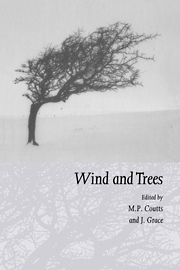Book contents
- Frontmatter
- Contents
- Preface
- List of contributors
- Part I Airflow over topography and in forests
- Part II Mechanics of trees under wind loading
- 7 Understanding wind forces on trees
- 8 Modelling mechanical stresses in living Sitka spruce stems
- 9 Experimental analysis and mechanical modelling of windinduced tree sways
- 10 Failure modes of trees and related failure criteria
- 11 An experimental investigation of the effects of dynamic loading on coniferous trees planted on wet mineral soils
- 12 Measurement of wind-induced tree-root stresses in New Zealand
- 13 New methods for the assessment of wood quality in standing trees
- Part III Tree physiological responses
- Part IV Impacts of wind on forests and ecology
- Part V Risk assessment and management response
- Index
9 - Experimental analysis and mechanical modelling of windinduced tree sways
Published online by Cambridge University Press: 27 October 2009
- Frontmatter
- Contents
- Preface
- List of contributors
- Part I Airflow over topography and in forests
- Part II Mechanics of trees under wind loading
- 7 Understanding wind forces on trees
- 8 Modelling mechanical stresses in living Sitka spruce stems
- 9 Experimental analysis and mechanical modelling of windinduced tree sways
- 10 Failure modes of trees and related failure criteria
- 11 An experimental investigation of the effects of dynamic loading on coniferous trees planted on wet mineral soils
- 12 Measurement of wind-induced tree-root stresses in New Zealand
- 13 New methods for the assessment of wood quality in standing trees
- Part III Tree physiological responses
- Part IV Impacts of wind on forests and ecology
- Part V Risk assessment and management response
- Index
Summary
Abstract
Investigations have been carried out for the purpose of understanding and predicting different types of storm damage to forest, such as stem, stock or root breaks. The tree sway mechanical model used enables the determination of the modal parameters, natural frequency and shape deflection of the stem, for the two or three first oscillation modes of the structure. Inputs are specific dendrometric data, including mass distribution and conicity of the stem, orientation and biomass of branches. The purpose of this model is to allow the estimation of the fundamental oscillation mode (responsible for stock or root breaks) and the first harmonic (probably responsible for stem breaks) and to simulate the influence on those parameters of silvicultural practices such as pruning and pollarding. For the moment, in our description, the tree stem is considered as a cantilever beam of circular section, rigidly embedded in the soil. Experimentally, the signal delivered by an extensometer plugged under the bark on the tree stem is analysed using a dual-channel signal analyser. The modal parameters of the dynamic behaviour of the tree are identified, including resonance frequencies and associated damping factors. The methodology is first applied to a laboratory tree scale model and a good fit of the experimental results to predicted values is shown. Preliminary experimental results from a young budding red oak indicate the sensitivity of the dynamic spectrum to such a biological change.
Introduction
For about 4 years the research team in wood mechanics of the Laboratory of Wood Rheology of Bordeaux (LRBB) has been conducting an analysis of the mechanical behaviour of tree structure.
- Type
- Chapter
- Information
- Wind and Trees , pp. 182 - 194Publisher: Cambridge University PressPrint publication year: 1995
- 8
- Cited by



